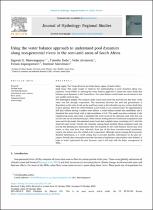| dc.contributor.author | Maswanganye, Sagwati E. | |
| dc.contributor.author | Dube, Timothy | |
| dc.contributor.author | Jovanovic, Nebo | |
| dc.date.accessioned | 2022-11-01T13:11:57Z | |
| dc.date.available | 2022-11-01T13:11:57Z | |
| dc.date.issued | 2022 | |
| dc.identifier.citation | Maswanganye, S. E. et al. (2022). Using the water balance approach to understand pool dynamics along non-perennial rivers in the semi-arid areas of South Africa. Journal of Hydrology: Regional Studies, 44, 101244. https://doi.org/10.1016/j.ejrh.2022.101244 | en_US |
| dc.identifier.issn | 2214-5818 | |
| dc.identifier.uri | https://doi.org/10.1016/j.ejrh.2022.101244 | |
| dc.identifier.uri | http://hdl.handle.net/10566/8117 | |
| dc.description.abstract | The Touws River in the Klein Karoo region of South Africa Study focus: This study sought to improve the understanding of pool dynamics along non-perennial rivers (NPRs) by utilising the water balance approach to assess the water fluxes that influence pool dynamics in the Touws River. The water balance model made use of various in-situ and satellite-derived data. New hydrological insights: The analysis of the water losses from the pool showed that most of the water was lost through evaporation. The interaction between the pool and groundwater is dependent on the water levels, as the pool loses water to the subsurface up to a certain depth then it starts gaining. When the Wolverfontein 2 pool is full, it can retained water for approximately 258 days without having a surface water inflow. | en_US |
| dc.language.iso | en | en_US |
| dc.publisher | Elsevier | en_US |
| dc.subject | Pool hydrodynamics | en_US |
| dc.subject | Water quality | en_US |
| dc.subject | Water pollution | en_US |
| dc.subject | Groundwater quality | en_US |
| dc.subject | South Africa | en_US |
| dc.title | Using the water balance approach to understand pool dynamics along non-perennial rivers in the semi-arid areas of South Africa | en_US |
| dc.type | Article | en_US |

